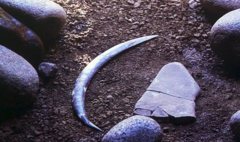The remarkable find sheds light on early human ingenuity and hunting strategies, expanding our understanding of prehistoric tool use.
The Discovery of the World’s Oldest Boomerang: A 40,000-Year-Old Artifact

The Discovery of the World’s Oldest Boomerang: A 40,000-Year-Old Artifact
Researchers unveil new insights into a 40,000-year-old boomerang, revealing its significance in ancient hunting practices.
In a groundbreaking discovery, the world's oldest boomerang has been dated to approximately 40,000 years old, surpassing prior estimates and providing crucial insights into human innovation and behavior of that era. The artifact, composed of mammoth ivory, was unearthed in Oblazowa Cave, Poland, back in 1985 but has recently been the subject of advanced radiocarbon dating techniques.
Initially believed to be around 30,000 years old, new analyses of animal and human bones found at the site suggest this remarkable tool dates between 39,000 and 42,000 years ago. Dr. Sahra Talamo from the University of Bologna emphasized its unique design, stating, "It's the oldest boomerang in the world, and the only one of its shape and size found in Poland." The findings not only highlight the craftsmanship involved in creating such a well-preserved item but also point to its potential hunting applications.
Unlike modern boomerangs known for their returning flight, this ancient tool was designed for throwing in a straight line, likely aimed at hunting. Its presence signifies how early Homo sapiens may have engaged in complex behaviors, possibly utilizing the boomerang for both practical and ceremonial purposes. The expertly carved ivory tool shows signs of polishing and specific curvature, indicating that it was tailored for a right-handed thrower.
While boomerangs are traditionally linked to Aboriginal cultures in Australia, this discovery illustrates the widespread occurrence of similar tools across the globe in prehistoric societies. The currently known oldest Australian boomerang, crafted from wood, dates to about 10,500 years, while various ancient finds across Europe, including Denmark and The Netherlands, suggest the use of such tools dates back thousands of years.
A collaborative research effort involving scientists from multiple countries has culminated in the publication of these findings in the journal PLOS One, emphasizing the shared human endeavor in tool-making and the interconnectedness of early societies across different continents.
Initially believed to be around 30,000 years old, new analyses of animal and human bones found at the site suggest this remarkable tool dates between 39,000 and 42,000 years ago. Dr. Sahra Talamo from the University of Bologna emphasized its unique design, stating, "It's the oldest boomerang in the world, and the only one of its shape and size found in Poland." The findings not only highlight the craftsmanship involved in creating such a well-preserved item but also point to its potential hunting applications.
Unlike modern boomerangs known for their returning flight, this ancient tool was designed for throwing in a straight line, likely aimed at hunting. Its presence signifies how early Homo sapiens may have engaged in complex behaviors, possibly utilizing the boomerang for both practical and ceremonial purposes. The expertly carved ivory tool shows signs of polishing and specific curvature, indicating that it was tailored for a right-handed thrower.
While boomerangs are traditionally linked to Aboriginal cultures in Australia, this discovery illustrates the widespread occurrence of similar tools across the globe in prehistoric societies. The currently known oldest Australian boomerang, crafted from wood, dates to about 10,500 years, while various ancient finds across Europe, including Denmark and The Netherlands, suggest the use of such tools dates back thousands of years.
A collaborative research effort involving scientists from multiple countries has culminated in the publication of these findings in the journal PLOS One, emphasizing the shared human endeavor in tool-making and the interconnectedness of early societies across different continents.




















